(捷进英语1)Unit1-电子教案
- 格式:doc
- 大小:68.50 KB
- 文档页数:5
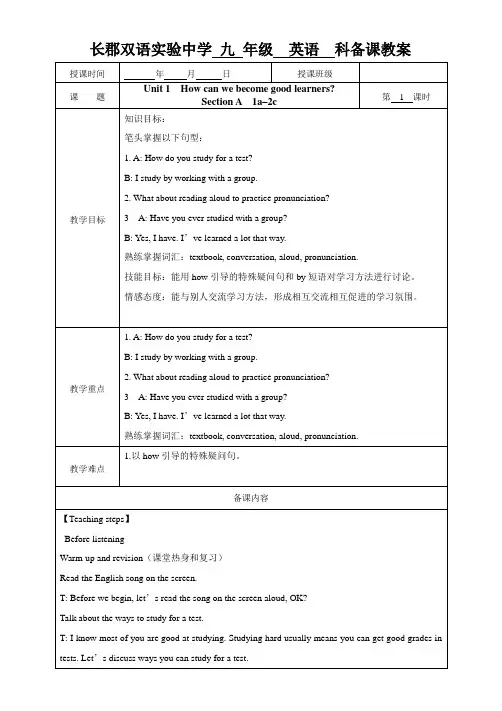
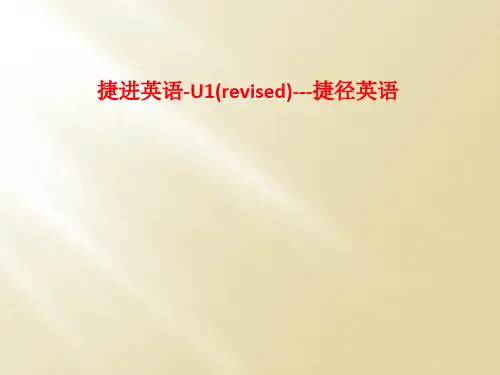
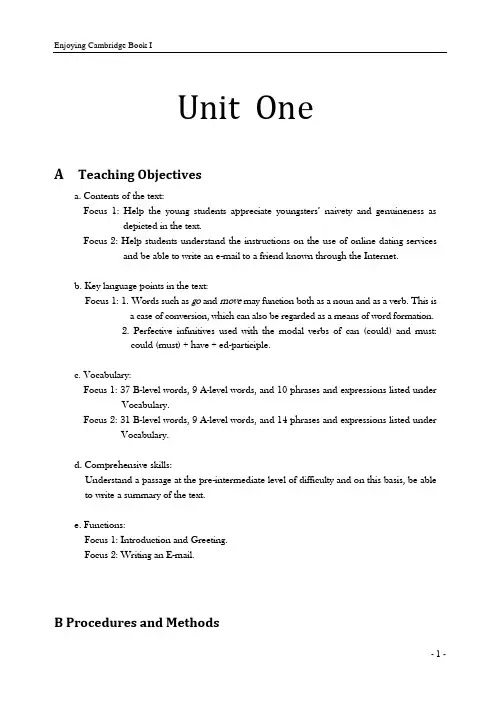
Unit OneA Teaching Objectivesa. Contents of the text:Focus 1: Help the young students appreciate youngsters’ naivety and genuineness as depicted in the text.Focus 2: Help students understand the instructions on the use of online dating services and be able to write an e-mail to a friend known through the Internet.b. Key language points in the text:Focus 1: 1. Words such as go and move may function both as a noun and as a verb. This isa case of conversion, which can also be regarded as a means of word formation.2. Perfective infinitives used with the modal verbs of can (could) and must:could (must) + have + ed-participle.c. Vocabulary:Focus 1: 37 B-level words, 9 A-level words, and 10 phrases and expressions listed under Vocabulary.Focus 2: 31 B-level words, 9 A-level words, and 14 phrases and expressions listed under Vocabulary.d. Comprehensive skills:Understand a passage at the pre-intermediate level of difficulty and on this basis, be able to write a summary of the text.e. Functions:Focus 1: Introduction and Greeting.Focus 2: Writing an E-mail.B Procedures and MethodsEight teaching periods are needed to cover the present unit.1. Period One and Period Two:●Step One:a. Background information:Most westerners begin dating in their early teenage years. Young people often go out in groups and meet at school dances or house parties. After dating a number of different partners, many teenagers begin “going out with” or “seeing” one special person at about 16 or 17. The three most popular first dates for those over 20 are lunch, dinner or a movie. People are staying single longer than before. First-time brides are usually around 26 and grooms are about 28.b. warm-up questionsAt what age did you start dating?How do you like your dating experiences?What is your parents’ attitude toward teenagers’ dating?(The warm-up exercise shall not take up more than 8 minutes.)and explain language points meanwhile.Questions about Para. 1(1) What kind of teenagers were the girl and the boy in this story?(2) What did they want to do while dating for six months?(3) What was it that they were too shy to do?Notes of Para 1:so:连词,意同also.So引导的子句是倒装句。
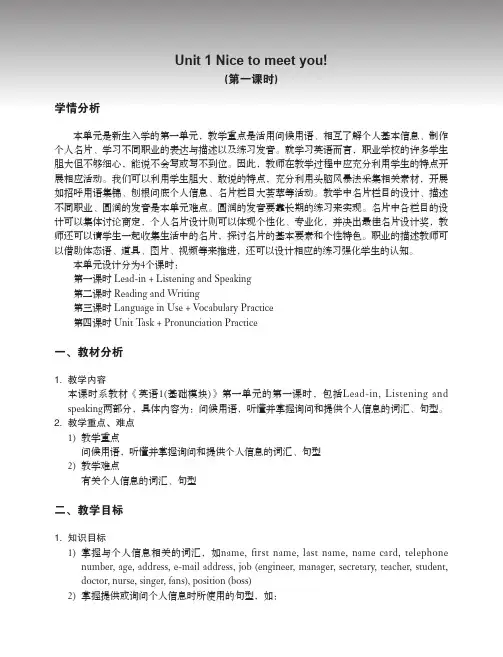
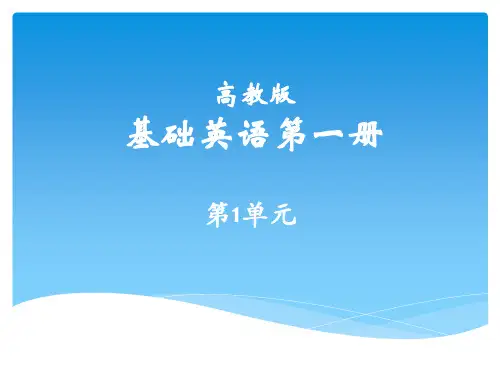
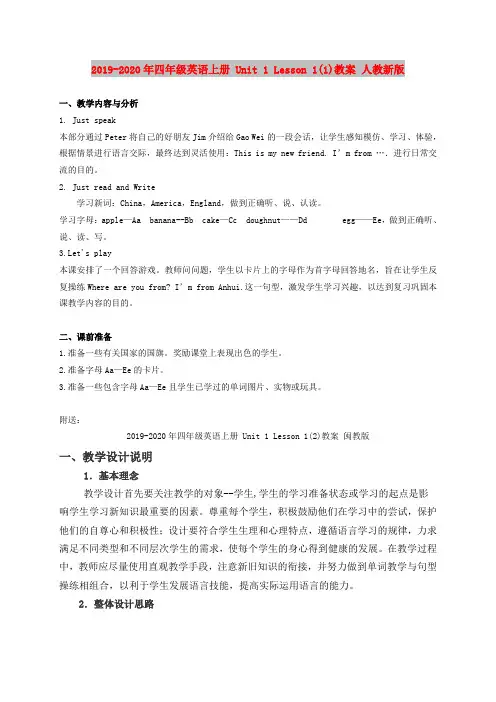
2019-2020年四年级英语上册 Unit 1 Lesson 1(1)教案人教新版一、教学内容与分析1. Just speak本部分通过Peter将自己的好朋友Jim介绍给Gao Wei的一段会话,让学生感知模仿、学习、体验,根据情景进行语言交际,最终达到灵活使用:This is my new friend. I’m from ….进行日常交流的目的。
2. Just read and Write学习新词:China,America,England,做到正确听、说、认读。
学习字母:apple—Aa banana--Bb cake—Cc doughnut——Dd egg——Ee,做到正确听、说、读、写。
3.Let's play本课安排了一个回答游戏。
教师问问题,学生以卡片上的字母作为首字母回答地名,旨在让学生反复操练Where are you from? I’m from Anhui.这一句型,激发学生学习兴趣,以达到复习巩固本课教学内容的目的。
二、课前准备1.准备一些有关国家的国旗。
奖励课堂上表现出色的学生。
2.准备字母Aa—Ee的卡片。
3.准备一些包含字母Aa—Ee且学生已学过的单词图片、实物或玩具。
附送:2019-2020年四年级英语上册 Unit 1 Lesson 1(2)教案闽教版一、教学设计说明1.基本理念教学设计首先要关注教学的对象--学生,学生的学习准备状态或学习的起点是影响学生学习新知识最重要的因素。
尊重每个学生,积极鼓励他们在学习中的尝试,保护他们的自尊心和积极性;设计要符合学生生理和心理特点,遵循语言学习的规律,力求满足不同类型和不同层次学生的需求,使每个学生的身心得到健康的发展。
在教学过程中,教师应尽量使用直观教学手段,注意新旧知识的衔接,并努力做到单词教学与句型操练相组合,以利于学生发展语言技能,提高实际运用语言的能力。
2.整体设计思路小学生的思维的基本特点是以具体形象思维逐步过渡到抽象逻辑思维为主要形式。
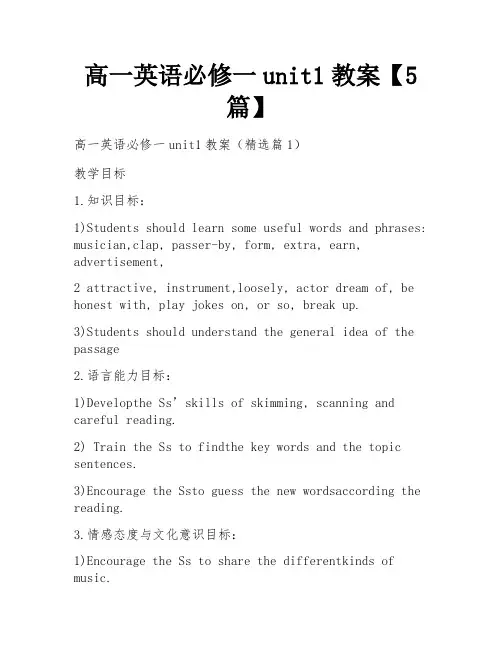
高一英语必修一unit1教案【5篇】高一英语必修一unit1教案(精选篇1)教学目标1.知识目标:1)Students should learn some useful words and phrases: musician,clap, passer-by, form, extra, earn, advertisement,2 attractive, instrument,loosely, actor dream of, be honest with, play jokes on, or so, break up.3)Students should understand the general idea of the passage2.语言能力目标:1)Developthe Ss’skills of skimming, scanning and careful reading.2) Train the Ss to findthe key words and the topic sentences.3)Encourage the Ssto guess the new wordsaccording the reading.3.情感态度与文化意识目标:1)Encourage the Ss to share the differentkinds of music.2)Improve the cooperation and share among the students.教学重难点1、教学重点:a.To understudend the passage better b.To find the main idea of eachparagraph2、教学难点:a.Master the reading ability b.Develop the skills ofreading教学过程教学设计本节课共45分钟,具体教学步骤如下:Step I Leading-in播放一段小视频,内容为歌曲 If you arehappy的英文版本,通过介绍演唱乐队twins引出本单元话题。
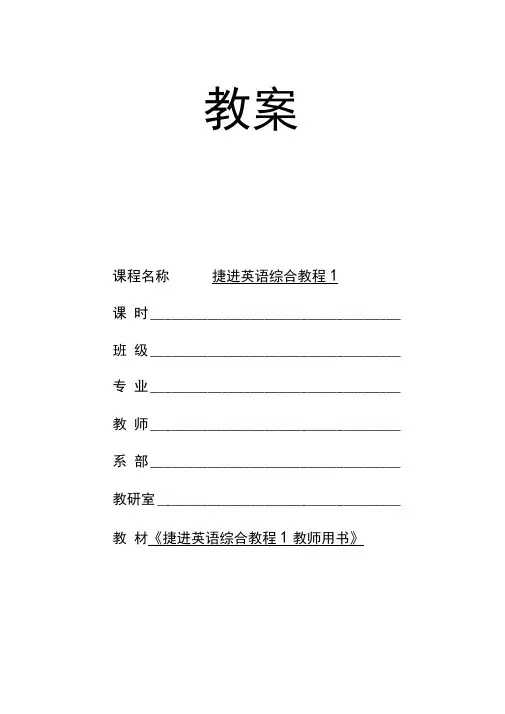
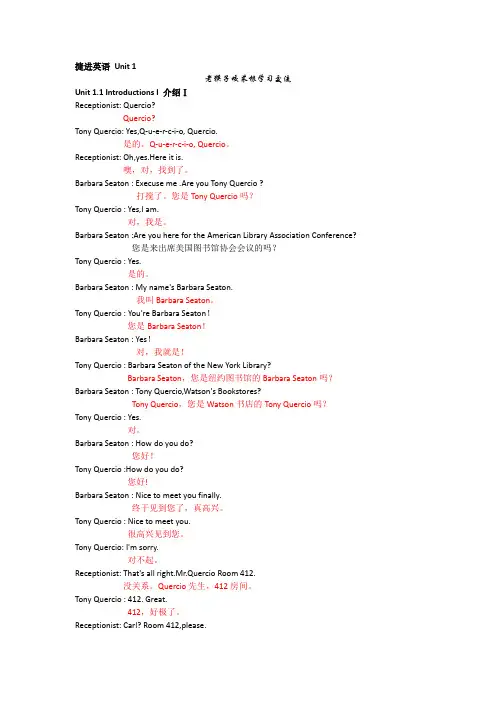
捷进英语Unit 1老猴子咬菜根学习交流Unit 1.1 Introductions I 介绍ⅠReceptionist: Quercio?Quercio?Tony Quercio: Yes,Q-u-e-r-c-i-o, Quercio.是的。
Q-u-e-r-c-i-o, Quercio。
Receptionist: Oh,yes.Here it is.噢,对,找到了。
Barbara Seaton : Execuse me .Are you Tony Quercio ?打搅了。
您是Tony Quercio吗?Tony Quercio : Yes,I am.对,我是。
Barbara Seaton :Are you here for the American Library Association Conference?您是来出席美国图书馆协会会议的吗?Tony Quercio : Yes.是的。
Barbara Seaton : My name's Barbara Seaton.我叫Barbara Seaton。
Tony Quercio : You're Barbara Seaton!您是Barbara Seaton!Barbara Seaton : Yes!对,我就是!Tony Quercio : Barbara Seaton of the New York Library?Barbara Seaton,您是纽约图书馆的Barbara Seaton吗?Barbara Seaton : Tony Quercio,Watson's Bookstores?Tony Quercio,您是Watson书店的Tony Quercio吗?Tony Quercio : Yes.对。
Barbara Seaton : How do you do?您好!Tony Quercio :How do you do?您好!Barbara Seaton : Nice to meet you finally.终于见到您了,真高兴。

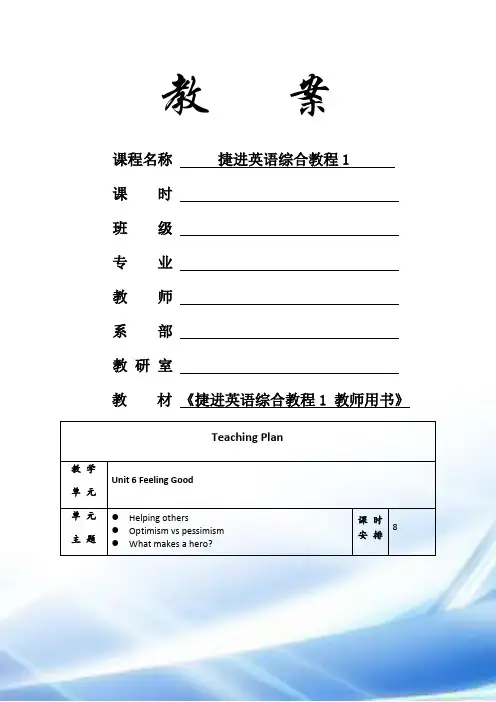
教案课程名称捷进英语综合教程1课时班级专业教师系部教研室教材《捷进英语综合教程1 教师用书》Teaching Plan教学单元Unit 6 Feeling Good单元主题●Helping others●Optimism vs pessimism●What makes a hero?课时安排8教学内容●Reading for learningWould You Like to Make a Difference?●Reading for DoingHalf Full or Half Empty?●Guided WritingA Letter of Thanks●Audio/Video Lab教学环节主要特色教学活动安排建议Warm-up(热身)This section introducesthe idea of feelings andreactions. It does thisthrough a set ofadjectives and musicclips for students toreact to.✧Depending on the time you have available,you could extend this into students playingtheir own music and discussing how themusic makes them feel.Reading (阅读)Readingforlearning◆This section startswith usingpronoun referentswhen reading tohelp understandthe organisation ofa text. It thenencouragesstudents to workout reasons in thetext.◆Vocabulary andGrammarStudents look atphrases and individualwords from the text.The grammar focus✧In Task 4 of Reading and Understanding,you could ask students to compare theirtranslations with a partner. Then ask studentsto close their books and translate them backinto English.✧In Vocabulary Focus, the three vocabularytasks draw on the text. Task 1 and Task 3 arealso a set of questions and so work well aspair-work discussion tasks.✧The Grammar Focus part looks at differentways of referring to the past, present andfuture with quite simple structures. Afterworking through the tasks you would setstudents a short written or spoken task usingthese structures to refer to their own desiresin the past present and future.✧Beyond the Text encourages students to reactlooks at would like to, like to and wanted to.◆Beyond the TextStudents interpret their own decisions. personally to the texts they have read. It also practices the grammar structure. Students could also think about and discuss their own good deeds.Reading for doing ◆Students read andanswer aquestionnaire onoptimism andpessimism.✧This section should take less time thansection A as the text is less complicated.They focus on developing students’ everydayreading skills as they are reading andresponding to a questionnaire.✧If time permits, students could create theirown scenario and options for others tochoose as an additional question in thequestionnaire.Guided Writing ◆Writing a letter ofthanks:(1) Formal expressionsof thanks(2) Informalexpressions ofthanks ✧When checking Task, 2 you could highlightsome of the other features of informality aswell as the vocabulary / phrases focused on,e.g. the punctuation and contractions.✧With weaker students you might want toshow them the model first before they writetheir email.Audio/Video Lab ◆Students watch avideo showingan interviewwith someonewho has donesomethingheroic:(1) making predictions(2) dictating andansweringquestions ✧Write hero onto the board and ask students todefine the word and to think of an example of one.✧When you get to Task 5, you will probablyneed to pause briefly between each question.Wrap-up ◆This sectionprovides a quickreview of thevocabulary,grammar, writing ✧For Task 1, Task 2 and Task 3 on thelanguage work, you might want to set themup as a team game or class quiz.✧For Task 4, it could be set as small groupand theme of theunit.◆Tasks could be setfor individualwork or done inpairs.discussion task.课后学习设计作业◆Finish all the exercises in Unit 6.◆Read the two texts in this unit again and try to summarisetheir contents.◆Write a letter of thanks to a person who ever helped you.课后总结和反思。
137 Unit 9 What club would you like to join?(第一课时)学情分析本单元的话题是俱乐部,该话题贴近学生生活,能引发学生兴趣。
本单元的教学重点是理解并学会运用一些表达加入俱乐部或参加某项活动时所需的词汇和句型,学会表达个人爱好及特长,学会申请加入俱乐部并能陈述理由,理解和制作俱乐部海报,运用一般将来时表达未来计划。
本单元的教学对象是外贸专业学生,该班总体学习气氛较浓,大多数学生对英语感兴趣,求知欲强,但个体之间差异非常大,学生普遍的问题如句式运用不到位、词汇积累不够、中文式英语等也还是客观存在。
针对此现象,教师可以考虑通过小组合作学习、同伴互助的方式引发更多学生自主学习,使更多学生愿意接受挑战,尽力完成各项语言任务。
一、教材分析1. 教学内容本课时系教材《英语1 (基础模块) 》第九单元的第一课时,包括Lead-in和Listening and Speaking两部分,具体内容为:选择合适的俱乐部广告语,听懂有关表达个人特长、爱好以及询问申请加入俱乐部的对话并掌握相关词汇、句型。
2. 教学重点、难点1) 教学重点听懂并掌握有关表达个人特长、爱好以及询问和申请加入俱乐部的词汇、句型2) 教学难点申请参加俱乐部时使用的词汇、句型二、教学目标1. 知识目标1) 掌握与俱乐部有关的词汇和短语,如united, in line, online, have fun with, fan, as high as,chat with, member, performance, qualification, fill in, form, application form, membership,schedule, certificate, experience, science club, join, website, fee, etc.2) 掌握有关表达个人爱好特长的句型,有关询问或提供俱乐部相关信息的句型,如:(1) about personal qualificationsSinging English songs is my favorite.I love playing chess.I enjoy painting very much.I like writing to my friends in English.I’m good at writing.138英语1(基础模块)电子教案(2) asking for informationWhat club do you like to join?What qualifications do you have?Now fill in this form, please.(3) giving informationI’m a member of the English club.Y ou can go to the club website to check the schedule.2. 能力目标1) 学生能听懂有关加入俱乐部和询问相关信息的对话;2) 学生能用所学句型简单表达个人的爱好、特长;3) 在日常生活中灵活应用学到的关键句型。
捷进初中语法教案1第一篇:捷进初中语法教案1第一课教学内容:人称代词主格,主系表结构及其“肯否问答”句型变换教学要求:能熟练掌握8个主格人称代词以及它们的主系表结构和“肯否问答”句型变换教学难点:人称代词作并列主语及主语是以s结尾的人名教学步骤:(共计45分钟)一、组织教学(5分)问候,简单介绍本册结构及课时安排,对大家的要求等等。
二、讲解(10-15分钟)1.简单介绍主系表结构2.8个主格人称代词 I, you, he, she, it, we, you, they注意:代词主格在句中作主语;you表两层意思:“你”、“你们”。
3.人称代词与系动词am, is, are的对应关系用好口诀:我跟am你跟are, is连着他她它,单数主语用is,复数主语全用are。
注意:Are he and she in Class One?(并列主语, 系动词要用are)Jones is from Canada.(以s结尾的单数名词作主语,系动词用is)4.主系表结构中的表语表语:说明主语的特征、类属、状态、身份等,常由名词、代词、形容词、副词、介词短语等担任。
He is Jim.(名词)I am fine.(形容词)They are here.(副词)She is at home.(介词短语)5.主系表结构的“肯否问答”句型变换He is ten.He is not ten.Is he ten?Yes, he is./ No, he isn’t.用好口诀:“变疑问,be提前,句末问号别忘记”;“变否定,更容易,be加not要牢记”。
提问: She is nine.(变否定句、疑问句,并作简答。
)注意以下两点:⑴ 主语为I/we/you时,变疑问句还可以这样变(有两种形式),如:right?⑵ 否定形式: is和are有三种形式,但am只有两种,I am old.→ Am I old? / Are you old?You are right.→ Are you right? / Am I 如:He isn’t.../ He’s not.../ He is not...I’m not.../ I am not...解释:is和are都可以直接和not构成缩略形式isn’t和aren’t,但am不可,没有amn’t这种形式。
2021-2022学年高教版英语1(基础模块)电子教案一、教学目标1.熟悉并掌握基础模块的教学内容。
2.扩展学生的词汇量和语法知识。
3.培养学生的听、说、读、写的综合能力。
4.培养学生的团队合作和沟通能力。
二、教学内容1.单词和短语的学习。
2.语法知识的学习。
3.阅读理解的训练。
4.听力和口语的练习。
5.写作和演讲能力的培养。
三、教学方法1.情境教学法:通过具体的情境和实际生活中的例子,让学生更好地理解和掌握知识。
2.合作学习法:组织学生进行小组合作学习和讨论,培养团队合作和沟通能力。
3.多媒体教学法:利用多媒体资源,辅助教学,提高学生的学习兴趣和效果。
4.情感教育法:通过情感因素的引导和培养,激发学生学习英语的兴趣和动力。
四、教学步骤第一课时1.导入新课:通过查找资料介绍英语课程的重要性和学习英语的目的,并与学生进行讨论。
2.学习新单词:教师呈现新单词,并帮助学生掌握其发音和词义。
3.练习新单词:教师组织学生进行单词的拼写和记忆训练。
4.学习新语法:教师介绍新的语法知识,并通过例句进行解释和练习。
5.听力练习:教师播放录音材料,要求学生仔细听,并完成相关的听力练习题。
6.口语练习:教师组织学生进行口语练习,要求学生使用所学的单词和语法知识进行对话。
7.小结和复习:教师对本课内容进行总结,并进行相关的复习练习。
第二课时1.复习前一课内容:教师通过问答的方式对前一课的内容进行复习和检测。
2.学习新单词:教师呈现新单词,并帮助学生掌握其发音和词义。
3.练习新单词:教师组织学生进行单词的拼写和记忆训练。
4.阅读理解:教师选择一篇适合学生水平的短文进行阅读,要求学生理解文中的内容,并完成相关的问题。
5.语法练习:教师设计语法练习题,要求学生运用所学的语法知识进行练习。
6.写作练习:教师提供一个写作题目,要求学生完成一篇短文,并进行互评。
7.录音练习:教师提供录音材料,要求学生模仿录音并进行朗读练习。
8.总结和反思:教师对本课内容进行总结,并引导学生进行学习效果的反思。